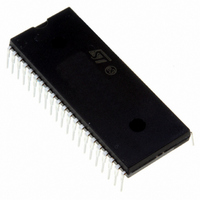ST72F324J4B5 STMicroelectronics, ST72F324J4B5 Datasheet - Page 42

ST72F324J4B5
Manufacturer Part Number
ST72F324J4B5
Description
MCU 8BIT 16K FLASH 5V 42DIP
Manufacturer
STMicroelectronics
Series
ST7r
Datasheet
1.ST72F324J2T6.pdf
(164 pages)
Specifications of ST72F324J4B5
Core Processor
ST7
Core Size
8-Bit
Speed
8MHz
Connectivity
SCI, SPI
Peripherals
LVD, POR, PWM, WDT
Number Of I /o
32
Program Memory Size
16KB (16K x 8)
Program Memory Type
FLASH
Ram Size
512 x 8
Voltage - Supply (vcc/vdd)
3.8 V ~ 5.5 V
Data Converters
A/D 12x10b
Oscillator Type
Internal
Operating Temperature
-10°C ~ 85°C
Package / Case
42-DIP (0.600", 15.24mm)
Processor Series
ST72F3x
Core
ST7
Data Bus Width
8 bit
Data Ram Size
512 B
Interface Type
SCI, SPI
Maximum Clock Frequency
8 MHz
Number Of Programmable I/os
32
Number Of Timers
2
Maximum Operating Temperature
+ 85 C
Mounting Style
Through Hole
Development Tools By Supplier
ST7F521-IND/USB, ST7232X-EVAL, ST7MDT20-DVP3, ST7MDT20J-EMU3, STX-RLINK
Minimum Operating Temperature
- 10 C
On-chip Adc
10 bit, 12 Channel
For Use With
497-6421 - BOARD EVAL DGTL BATT CHGR DESIGN
Lead Free Status / RoHS Status
Lead free / RoHS Compliant
Eeprom Size
-
Lead Free Status / Rohs Status
Details
Other names
497-4848
Available stocks
Company
Part Number
Manufacturer
Quantity
Price
Company:
Part Number:
ST72F324J4B5
Manufacturer:
STMicroelectronics
Quantity:
135
ST72324Jx ST72324Kx
POWER SAVING MODES (Cont’d)
8.4 ACTIVE-HALT AND HALT MODES
ACTIVE-HALT and HALT modes are the two low-
est power consumption modes of the MCU. They
are both entered by executing the ‘HALT’ instruc-
tion. The decision to enter either in ACTIVE-HALT
or HALT mode is given by the MCC/RTC interrupt
enable flag (OIE bit in MCCSR register).
8.4.1 ACTIVE-HALT MODE
ACTIVE-HALT mode is the lowest power con-
sumption mode of the MCU with a real time clock
available. It is entered by executing the ‘HALT’ in-
struction when the OIE bit of the Main Clock Con-
troller Status register (MCCSR) is set (see
10.2 on page 56
register).
The MCU can exit ACTIVE-HALT mode on recep-
tion of either an MCC/RTC interrupt, a specific in-
terrupt (see
page
HALT mode by means of an interrupt, no 256 or
4096 CPU cycle delay occurs. The CPU resumes
operation by servicing the interrupt or by fetching
the reset vector which woke it up (see
When entering ACTIVE-HALT mode, the I[1:0] bits
in the CC register are forced to ‘10b’ to enable in-
terrupts. Therefore, if an interrupt is pending, the
MCU wakes up immediately.
In ACTIVE-HALT mode, only the main oscillator
and its associated counter (MCC/RTC) are run-
ning to keep a wake-up time base. All other periph-
erals are not clocked except those which get their
clock supply from another clock generator (such
as external or auxiliary oscillator).
The safeguard against staying locked in ACTIVE-
HALT mode is provided by the oscillator interrupt.
Note: As soon as the interrupt capability of one of
the oscillators is selected (MCCSR.OIE bit set),
entering ACTIVE-HALT mode while the Watchdog
is active does not generate a RESET.
This means that the device cannot spend more
than a defined delay in this power saving mode.
CAUTION: When exiting ACTIVE-HALT mode fol-
lowing an interrupt, OIE bit of MCCSR register
must not be cleared before t
rupt occurs (t
42/164
1
MCCSR
OIE bit
0
1
36) or a RESET. When exiting ACTIVE-
HALT mode
ACTIVE-HALT mode
Power Saving Mode entered when HALT
DELAY
Table 8, “Interrupt Mapping,” on
for more details on the MCCSR
instruction is executed
= 256 or 4096 t
DELAY
after the inter-
CPU
Figure
delay de-
Section
26).
pending on option byte). Otherwise, the ST7 en-
ters HALT mode for the remaining t
Figure 25. ACTIVE-HALT Timing Overview
Figure 26. ACTIVE-HALT Mode Flow-chart
Notes:
1. This delay occurs only if the MCU exits ACTIVE-
HALT mode by means of a RESET.
2. Peripheral clocked with an external clock source
can still be active.
3. Only the MCC/RTC interrupt and some specific
interrupts can exit the MCU from ACTIVE-HALT
mode (such as external interrupt). Refer to
Table 8, “Interrupt Mapping,” on page 36
details.
4. Before servicing an interrupt, the CC register is
pushed on the stack. The I[1:0] bits of the CC reg-
ister are set to the current software priority level of
the interrupt routine and restored when the CC
register is popped.
[MCCSR.OIE=1]
INSTRUCTION
RUN
HALT INSTRUCTION
N
(MCCSR.OIE=1)
HALT
ACTIVE
INTERRUPT
HALT
Y
256 OR 4096 CPU
CYCLE DELAY
3)
INTERRUPT
RESET
OR
256 OR 4096 CPU CLOCK
OR SERVICE INTERRUPT
FETCH RESET VECTOR
OSCILLATOR
PERIPHERALS
CPU
I[1:0] BITS
OSCILLATOR
PERIPHERALS
CPU
I[1:0] BITS
OSCILLATOR
PERIPHERALS
CPU
I[1:0] BITS
N
CYCLE DELAY
RESET
Y
1)
VECTOR
DELAY
FETCH
2)
RUN
XX
XX
OFF
OFF
OFF
for more
period.
ON
ON
ON
ON
ON
ON
10
4)
4)













